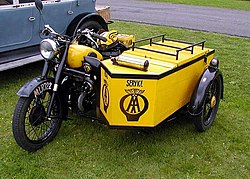| Revision as of 09:20, 6 June 2006 edit85.210.38.160 (talk) Corrected the word "Farnborough"← Previous edit | Revision as of 01:54, 14 June 2006 edit undoCydebot (talk | contribs)6,812,251 editsm Robot - Moving category per WP:CFD at Misplaced Pages:Categories for deletion/Log/2006 June 3.Next edit → | ||
| Line 48: | Line 48: | ||
| ] | ] | ||
| ] | ] | ||
| ] | ] | ||
Revision as of 01:54, 14 June 2006
The Automobile Association (also referred to as The AA) is a British motoring organisation.
History
On June 29, 1905 a group of motoring enthusiasts met at the Trocadero restaurant in the West End of London. This was the inauguration of the Automobile Association, formed to help motorists avoid police speed traps.
By 1906 the association took a stand on road safety issues, and erected thousands of roadside warning signs.
In 1908, the AA published the AA Members' Special Handbook, a list of nationwide agents and mechanics. The following year saw the introduction of the AA's free legal system.
Between 1910 and 1929 the AA introduced AA Routes. To this day, the association continues to produce travel guides and maps. AA Publishing has grown to be the UK's dominant publisher of travel literature. Also, from 1912 the AA began inspecting hotels and restaurants, issuing the coveted AA Star Classification to those deemed to be of superior quality. By 1914, the AA had grown to 83,000 members. In the 1920s the association introduced pre-purchase and post-accident repair checks.
By 1939, the AA's membership had grown to 725,000, a number equivalent, at the time, to 35 percent of all cars in the United Kingdom. When World War II ended the AA began to protest about wartime petrol rationing. The campaign was successful and rationing was repealed in 1950. This was the first of many campaigns, led by the AA, that were aimed at championing the rights of British motorists.
Other campaigns in which the AA have been instrumental, include the compulsory wearing of seat belts, and the introduction of lead-free petrol. Seat belt legislation became law in the UK in 1983.
1949 saw the launch of the AA's breakdown and recovery service. Initially only available in London and surrounding districts, it has been gradually extended to cover most of the UK.
The AA Insurance brokerage service started life in 1967. Today, AA Insurance is the UK's largest motor insurance company. The service was later extended to cover home and life insurance.
In 1973 AA Roadwatch began broadcasting traffic alerts on UK commercial radio stations. It grew to become the largest broadcaster of traffic information in Europe. AA Relay was introduced later that year, a service that promised to deliver a broken-down vehicle, its driver and passengers, luggage and trailer to anywhere in Britain.
In 1992, the AA Driving School was launched and now employs more than 1,300 qualified driving instructors. By 1994, AA's membership was at eight million and growing. Current estimates place the figure at over twelve million members.
In 1999 the association demutualised and was sold to Centrica, the holding company of British Gas. Each full personal member of the association's breakdown services in the UK and Ireland received a payout of over a hundred pounds, which, for many of them, was more than they had ever paid in membership fees. A new organisation, the AA Motoring Trust, was formed in 2002 to take over the non-commercial activities of the AA.
In 2004 the AA was sold for GBP 1.75 billion to two European private equity firms, CVC and Permira.
The Headquarters building for the AA was opened in 1973 by The Queen. It is called Fanum House and is located on Basing View, Basingstoke, Hampshire. Whilst the AA was under Centrica control in 2001 the HQ was moved to an office in Farnborough (also in Hampshire), but returned to Basingstoke as of 01/10/2005 following the sale to CVC Permira.
See also
- AA Motoring Trust — The AA's road safety charity
- American Automobile Association
- Royal Automobile Club



